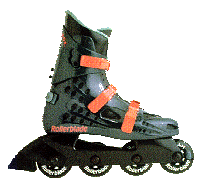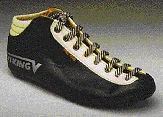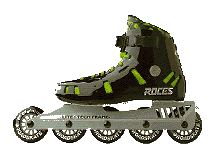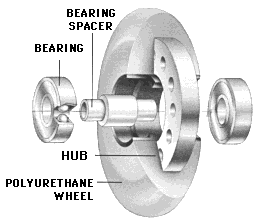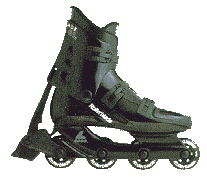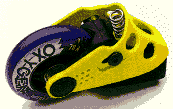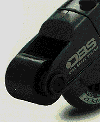What This Guide Is
|
This guide is meant to provide you with an organized and no-nonsense approach
to skate shopping. It is intended for those readers with little or no
knowledge of inline skates. This guide is not review-oriented and any
specific products mentioned are as examples only.
(See part 3.3 of the FAQ for skate reviews.)
As with all purchases, always read the fine print before buying. Make sure you can return the merchandise if it is found to be broken, defective or otherwise unsatisfactory after you purchase it. Warning: this guide may be offensive to salespeople (aka "salesdroids") who pretend they know something about inline skates when they sell them in stores. If you're not one of those fakers, then don't worry about it. If your store is providing really good service (such as free wheel rotation for your customers, calling them up about wheel specials, replacing a lost spacer for free, etc.), I don't think a few words from the internet is going to disuade people from giving you their business. If anything, you have the chance to show that not only are you NOT a salesdroid, but that you are actually somewhat inline savvy. If you really want to thank me for writing this article, do me a favor and wear your helmet, learn to brake, and skate under control. And as always, be courteous to pedestrians, kids, bikers and other skaters.
-Tony Chen, adchen@skatefaq.com
|
|
Do you want to know more? |
||
|
» Read related articles » Buy related books » Other books from Skate FAQs Store » Join the Inline Skaters Network |
||
Table of Contents:
- Before you go to the store
- At the store
- After you buy
- Here's a checklist for you to print out to take to the store.
Before You Go To The Store
|
Okay, so you've heard about "rollerblades", you've seen the ads, you've
watched rollerhockey on TV, you see skaters on the streets and on the
sidewalks, and now you want a piece of the action too. Where do I go? What
kind of skate should I buy? How much will it cost me? What's the best skate
out there?
While this guide doesn't pretend to be the final word on all skate shopping issues, hopefully it'll help shed some light on those questions and how to go about choosing the proper skates. Shopping for inline skates is much like shopping for a car. Your best bet is to go armed with information and to know what each skate feature means for you and your skating. Don't listen to the hype. Use your brain. About 99.5% of the salespeople in stores I've come across know less than I do about the skates they're selling. Many times I pose as an uninformed shopper and ask the standard questions. Almost always the answers are rehashed phrases from manufacturers' brochures. They throw out buzzwords like "durometer", "ABEC", and "ABT" to sound like they actually know something. Don't be thrown off. Just show them a printout of this guide, and tell them Tony said they're full of baloney.
|
Tip #1: "Your best bet
is to go armed with information and to know what each skate feature means for
you and your skating. Don't listen to the hype."
|
Decide Your Needs
|
If you go into the store without a clear goal in mind, you could easily end
up getting something you don't want. It's like grocery shopping while you're
hungry - you tend to buy everything that looks appealing. So before you put
a single big toe inside the store, answer these two questions first:
First, let's tackle the type of skating you want to do. You can do all sorts of things on skates: figure skating, hockey, ramps, stair riding, hills (both up and down), speed skating, commuting to work or classes, and on and on. The thing to decide here is mainly between these types of skates: multi-purpose, hockey, or speed. Most of you will probably be looking at multi-purpose skates. These are sometimes labeled by the manufacturers as "cross-training/fitness" and "recreational". Translation: "costs more" and "costs less", respectively. Another type of multi-purpose skate that has become very popular is the "aggressive" or "street" skates which are specifically designed for grinds, railslides, and other common skating tricks. These skates usually come with grind plates (plastic or metal covers that go on the runners), smaller harder wheels, and rugged shells. Multi-purpose skates comprise the large majority of the inline skating market. These skates are usually made of plastic with a foam liner inside. Some have all laces, some all buckles, and some have combinations of both. A typical example is the 1994 Rollerblade Macroblades Equipes (EQ) (see picture).
|
| |||||||||||||||||
|
Hockey Inline Skates are usually made of stitched leather and/or ballistic nylon, like those you see ice hockey players wear. Very few, if any, use a foam liner (although of course many players use recreational skates for hockey). Hockey skates will tend to be great on the rink, but won't stand up as well to shocks and abrasion from outdoor surfaces. Hockey skates will use laces, with some models having an additional velcro strap at the ankle. Some models also have toe or side plates to protect the leather when you fall. In the past, hockey skates were almost always slightly modified recreational skates. Today, there are dozens of models by most of the big names from ice hockey to choose from: Bauer, CCM, Koho, etc. You'll see two kinds of models: production skates with both boot and frame, and component skates. The production models are typically revamped or modified recreational skates, (i.e., plastic boot, foam liner, and plastic frame). The component skates usually have a boot from one company plus a frame by another manufacturer like Labeda or Sure-Grip. The component hockey frames are usually made of some aluminum alloy (like racing frames). Mounting the frames usually requires riveting the frame to the sole of the boot. Most all the serious hockey skates use the component approach.
|
| |||||||||||||||||
|
Speedskates and 5-wheelers
Component Skates Speedskates are cut low at the ankles. Most all are laces-only, but some have one buckle at the ankle. If you're looking at racing skates you might want to pick out your components separately. The four main components you'll have to consider are the boots, frames (runners), bearings, and wheels. An example of a boot and frame are the Viking Marathon Special boots and the Mogema frames, shown to the right. |
|
|||||||||||||||||
|
If you're looking at getting component skates, you'll find there's a wide variety of boots and frames to choose from. Racing frames are usually made of an aluminum alloy, although you will find the more expensive frames made of fiberglass/carbon fiber type materials too (mainly for lightness). There are different types of aluminum alloy, denoted by a Series number.
In general the higher series have better strength characteristics but may suffer from lower corrosion resistance.
Most racing frames are made in one of three ways:
Most of the mid/high-end frames out there tend to be machined or extruded. You may see the term "triple-extrusion". I'm not sure what this means. Maybe they have some sort of 3-step process to extrude the frame. Boots also vary widely in material, but are usually made of some type of leather. Most Bont boots, for example, are made of kangaroo leather. Some boots will have a combination of leather and carbon/graphite material for strength and weight-reduction. Racing boots often are heat-moldable, so that you can warm them up (like in an oven or with a heat gun) and then mold them to your feet. This is a somewhat tedious process, but the results are well worth it. Having a near-perfect fit to your feet helps conserve energy and gives you a better feel of the road. Some boots are only partially moldable, and some are fully moldable (usually the more expensive models). Buying components separately is typically the most expensive approach (short of getting entirely custom skates) but also provides the best fit for your skating needs. You get what you pay for.
| ||||||||||||||||||
|
Production 5-wheelers The other 5-wheel option is to buy pre-assembled 5-wheel production skates which are generally considered more for recreational speedskating and long-distance skating. These skates have plastic boots with either metal or plastic runners. They will be a lot heavier than component speedskates in almost every case. Some are cut lower or higher depending on their intended usage. For example, the Roces Paris (CDG) skates has a plastic vented boot cut moderately low, laces, one buckle, and metal runners:
Technically, it's not the extra wheel that makes these skates go faster, it's the extra length in the wheelbase. The longer wheelbase makes the skates more stable at higher speeds. The trade-off (there's always a trade-off) is that they're much less maneuverable than 3 or 4 wheel skates. You may find some 4 wheel skates that have their wheels spread a lot farther apart than normal to achieve a longer wheelbase. I know of one K2 cross-trainer model that has long runners with axle holes designed to let you use either 4 or 5 wheels. There is also a Bauer cross-trainer skate that has the wheels spread far apart (but without the extra axle holes).
|
|
|
Okay, now that you've chosen the type of skate to buy, the next thing to do
is to decide what's most important to you in a skate. Let me quote the
all-purpose law of consumer goods:
"Good, Fast, Cheap. Pick two."For skates, "good" usually translates into "comfortable and durable"; "fast" is usually "quality of construction and parts" (which let you go faster). Basically you have to choose what's the LEAST important to you. For most people that I've counseled in skate shopping, the price usually turns out to be the least important (You're probably scrunching your face and shaking your head muttering "What?? Is he crazy? I only have $X to spend!" Read on.) In general, the more money you put up front, the less it'll cost you in the long run. But on ONE condition! This is assuming you will be using your skates, and continue to skate for years to come. If you're going to buy them, try them once, and throw them in the closet, then go directly to Toys-R-Us or K-mart and buy the $35 skates with bright neon green and purple colors. Do not pass GO, and do not collect $200.
|
Tip #2: Avoid cheap-o skates if you want to enjoy
your skating.
|
|
|
So how does paying more up front save you more in the long run? If you buy cheapo skates, your skating experience will suck. Plain and simple. If you buy bad skates, then after a couple weeks of aches and pain, you'll say "See, Tony I told you so. Good thing I didn't spend more money." Wrong. Don't confuse cause and effect. Like most things in life, the rule is GIGO: garbage in, garbage out. You get out of it, what you put into it. To put it another way, the better skate that you buy, the better it fits. The better they fit, the less pain you endure. The less pain you endure, the less blisters you'll get on your feet. The less blisters you have, the less blood that oozes from them, and the more you like skating. I said it'd cost you less, and it will...in terms of pain, sweat, tears, blood, time, and bandage money. Not only that, if you enjoy the skating, you'll want to go out and skate even more. In turn, this means you'll learn to skate better and get more for your money. Make sense? Good! (If not, get ready to buy some bandages!)
|
||
|
Decide Your Price RangeThe Crummy Skate Threshold (CST)Now, in the previous section I made it seem like you should go out and spend your life savings on the best skate you can find. Well, only if you want to. As with most things, diminishing returns takes effect. $150 skates are definitely more than 5 times better than $30 skates. But are $300 skates twice as good as $150 skates? Well, it depends. The bottom line is to stay above what I call the Crummy Skate Threshold, or CST for short. In my experience, the CST is at around $110-120 (all dollar figures are US$; adust for your standard of living and currency as needed). Skates retailing under the CST usually aren't worth their money. You'd be a whole lot better off putting that money towards a good pair of good skates. Note that the CST applies to the brand-new price, and not to used or close-out, or last-year's-model prices. You may find good skates at clearance sales or skates that have been used. If so, go for it. (See the Shopping for Used Skates section for more details). As a general rule though, stick with the CST. Make sure you factor in $60-$90 for protective gear when trying to estimate your total cost. I would highly, highly, HIGHLY recommend (I'd make it mandatory if I had the power) wrist guards ($10-15) and knee pads ($15-50) for beginners. Elbow pads ($10-15) are also highly recommended. Nowadays, you can find combo packs of knee pads, elbow pads and wrist guards for a reduced price. Once you're bleeding at the hands and knees, it'll be too late to wish that you had spent that puny extra $40 up front. Sound like the bloody blister scenario? That's right. Oh, and GET A HELMET! I mean it! You can break your arms or legs and still live. You don't want to break your head. Spend the $30-40 for the helmet. An ANSI or Snell approved bike helmet works just fine. If you have a really old helmet though, toss it and shell out $40 for a nice new safer one. Make sure it fits as snug as possible without hurting. It should not slide around on your head. That won't provide you with adequate protection in a real crash. And always wear the straps fitted correctly. If your straps are not on, or are on too loosely, your helmet will probably fall off before impact. |
$150 skates are five times better than $30 skates. But are $300 skates twice as good as $150 skates? |
|
Mail Order vs. Local Stores If all this sounds like you have to spend your life savings again, let me quote what Mr. Spock said to Scotty in the Galileo 7 episode of the old Star Trek series, when their shuttle crashed on a planet and Scotty exclaims that all is lost because most of their fuel was lost in the landing: "Mr. Scott, there are always alternatives." Of course in the end through Star Trek magic, Scotty converted their phasers' energy to shuttle fuel. Amazing. Wish they would show us how to convert bullets to gasoline. In your case, you don't have to find Scotty, but you can find a mail-order shop. [NOTE: To bring this article into the 21st-century, you can replace "mail order" with "online ordering"!]
Mail-order can save you a substantial amount of money without
sacrificing quality. However, the trade-off is (there's that "t"-word again)
that you can't try on the skates or gear before you buy.
You might have to ship the skates back once or more, if things aren't quite
right or what you expected. And of course, you have to wait for UPS or
snail-mail (USPS), to ship it to your door.
One thing that will help is to try out the same skates at your local store. This only works mainly if you're shopping for recreational skates. Don't count on finding speedskates at most stores unless you're lucky enough to have a dedicated skate shop around. Try on skates to figure out the size that fits best, and then you can go shopping for price. Note that sizing is NOT consistent between all manufacturers, so be sure to compare apples with apples. To some people this may seem like you're using the store for free. However, if you feel like the service and convenience they give you is worth the price they charge (it could be close to or even cheaper than mail-order) then by all means buy them there. You won't have to pay for shipping, you get to start skating immmediately, and your local store gets some business. Prices in stores can often be lower or near mail-order, so never count out the local stores. If your budget is really tight, one thing you might try is to negotiate the price with the salespeople. This probably only works in non-chain stores, where they may actually be willing to bargain. If they won't budge, maybe the store owner will. Tell them, "You know I really like these skates, but $275 is a little high for me. I see them listed for $240 in the catalogs but I'd love to do my business in town with you instead. Do you think you could help me out here?" Probably won't work many times, but you won't know if you don't ask! The worst that can happen is that they say "Sorry, but we can't do that." The best that could happen is that they match, or maybe meet the price halfway. Better than nothing! Having said all that however, let me just say that my own experiences with ordering skates and other accessories through the mail have been very satisfactory. And on the plus side, pretty much all the salespeople at the mail-order shops know what they're talking about. Store salespeople ARE improving though, so hopefully your shopping experience will be good all around. For a list of mail-order shops, look at part 3.2 of the FAQ
|
Online ordering may save you some money, but you won't get the convenience or personal service. The trade-off is up to you.
|
Learning the TerminologyAll right, now we're on a roll, so to speak. You know what sort of skate you're looking for, you know your target price range, and you're ready to jump into that store and start trying on skates. Before you do though, go through the following terms and get an idea of what each means. Once you're beyond trying on skates for comfort and fit, you'll want to compare the other features to see what's best for you.(Note: For more detailed wheel and bearings information see Wheels & Bearings.)
|
|
|
Not all skates can take larger wheels though. Most every 76mm skate will take up to 80 or 82mm (plenty large for most people). 72mm skates are another story. Depending on the runner and chassis design, some can take only up to 72.5mm wheels, while others can squeeze on 76mm ones. Some people actually shave or grind down parts of their skates so that they can fit larger wheels. In any case, if you can afford it, I'd suggest going with skates that can take at least 76mm wheels. You can always switch to smaller wheels if you want.
Most wheels are 78A or 82A. 78A is considered on the softer side. They don't last quite as long as 82A's, but since they're softer, they absorb bumps better for a smoother ride. That's the primary trade-off when you go about selecting wheel hardness. For most stock skates, you won't have a choice, since they almost all come in 78A. If you want or need harder wheels, you can buy a harder set when your original wheels wear out. For indoor surfaces, most skaters go with really hard wheels, like 85A or higher. For real rough outdoor terrain, you might want 74A. You can also mix your durometers and have some wheels harder than others. This let's you gain the advantages of both worlds somewhat, by getting the better shock absorption of softer wheels, while getting the durability of harder wheels.
|
|
||
|
Braking systems:
Before 1994 the only thing you had to worry about with brakes was learning to use them. Now, you have to decipher the SSHA, or Silly Sales Hype Acronyms. Rollerblade has the ABT (Active Braking Technology), Oxygen skates have the PBS (Power Brake System), Bauer has the Force Multiplier, CCM has the Arrester Dual System, Roces has the Tartaruga, Ultra-wheels has the DBS (Disc Brake System) and I'm sure someone else will come up with yet another system. What we REALLY need is an industry-standard for brakes, not everyone trying to come up with the next better mousetrap. Right now, every single manufacturer has their own brake design. None are compatible (without modifications) with any other manufacturer's skates. Even Rollerblade's ABT and non-ABT brakes are incompatible. In any case, Rollerblade's ABT is essentially a brake on a long screw, running up the back of your skates. You can adjust the height of your brake by turning the screw. It also means the brake can be activated if you tilt or lean back on your skate. An example is the Rollerblade Bravoblade GL ABT skate:
If you have an older skate and want ABT, there is now an add-on system called GEM which does much the same thing:
The Oxygen PBS doesn't allow you to adjust the brake height, but instead it works like most brakes, with the added effect of pressing the brake pad against the rear wheel when you brake.
The Ultra Wheels DBS is a cylindrical brake oriented to roll in the same direction as the wheels. Inside the brake is a disc-braking system that provides extra braking power.
The Roces Tartaruga system is a spring-loaded device that clinches brake pads on the two rear wheels (from the side) when you press down in a certain way with your heel. The bottom line is that these system are neither bad nor good. On the plus side, they help beginners brake easier and some systems like the ABT allow you to adjust the height of the brake pad, which is very handy and can extend the life of the brake. On the down side, the brake pads may be harder to find (ABT brakes have been hard to find, last I heard). Also, for true expert power-braking, these systems actually get in the way. (See part 2.1 of the FAQ for braking techniques.) Learning to brake effectively under various conditions still takes practice, not just spending money on a fancy braking system. This is quadruply true for those add-on devices like the Grip, which are hand-activated caliper-brakes. One last thing to mention. Not all brakes are equal. In the past, Bauer and Roces brakes have been notorious for poor durability. Rollerblade brakes tend to last very well. This may or may not be true any more though. Ask other skaters that use Roces or Bauer skates. Things may have improved recently. Anecdote time: back in 1991 or 1992, my buddy Dave got some Bauer skates from the rest of us for his birthday. Boy, was he happy. That is, until he found out that Bauer brakes last about as long as a snowflake at noon in the Sahara Desert. He went through one brake in about 2 hours. Good thing for him, the rest of us were about ready to order some wheels and he ordered 5 brakes. We got our stuff in a few days and it turns out the catalog meant 5 SETS of brakes, meaning 10 brakes in all. Good thing too. He needed every one of them! |
Tip #3: Braking systems can be neat, but they are no substitute for actually learning how to brake and
stop as a skill. Take the time to learn it - you won't regret it. |
At The StoreAll righty. Now you know what you're looking for, you know all the nifty terms that go along with skates, and you're ready to head to the stores and see what they have. Before you go though, bring two things: athletic socks and a ruler with cm/mm markings (a ruler? you'll understand why later on.)
SocksWear the socks that you'll be wearing to skate, when you try on skates. I suggest getting double-layered anti-blister socks. However, if you insist on the hole-ridden tube socks you've been wearing for the past 5 years, that's your choice 8-) Make sure the socks are not too short or thick. You want the socks to cover at least 4-5 inches or more above your ankle bone (assuming you are trying on regular production skates, and not speedskates).Some people do actually skate barefooted, but that's a personal preference. It may cause more chaffing though without socks. Personally, I think my skates smell enough when I *do* wear socks 8-) but hey to each his/her own. If you have problems with blisters, try polypropylene sock liners under your other socks. These are very thin and hydrophobic (won't absorb moisture from your sweat) which means they wick sweat towards the outer layers of your socks. This keeps your feet dryer and less prone to blistering. You might need thinner outer socks too, if you find that the layers are bunching up in your skates.
Get readyOkay, now you're in the store. Remember our strategy? That's right, "Ignore the sales hype." If you've prepared ahead of time as I've told you to, that should be a piece of cake. Ice cream cake. Chocolate-mint ice cream cake even (I've always been partial to chocolate-mint).Okay, here's one part that the salesdroids are good for and good at. Pick out a skate that is exactly at your target price (there might be several models) and ask to try on one or all of them (if you want to be really thorough). You might find that your skate size will not be exactly your shoe size. Usually skates run a tad large meaning you'll have a smaller skate size than your shoe size. Try on skates a half-size larger and a half-size smaller than your normal shoe size to see the difference. Some manufacturers are better than others at providing skates for different shaped and sized feet. Rollerblade skates, for example, have tended not to be designed that well for wide feet. Bauer and Roces have done better in this regard. Also, for those of you who are just as confused as I am about Rollerblade's MondoPoint sizing system, here is a scan of their sizing chart that shows the U.S. men's and women's sizes versus MP: |

|
After you've got the skates on, wiggle your toes. You'll want to press your
ankles back against the heel of the skate, while you wiggle. If your toes are
crammed against the front of the skates, they're too tight. If your foot can
jiggle around inside the skates while you hold your foot up (like a clapper in
a bell), then they're too large. You want a snug fit -- as snug as possible
without hurting.
Okay, the skates are on and snug, so now stand up (slowly!) and put your weight on each foot and see how it feels. Wiggle your toes some more if you want. Remember that most people have asymmetrical feet. If one foot feels less comfortable than the other, you might ask to try on a skate of a different size for that foot. Most stores probably won't let you buy skates sized different for both feet, but you can at least try to minimize the discomfort for both feet combined. Shuffle around in the store for a couple minutes (hopefully it's carpeted) and let the liners conform to your feet a little bit. Re-tighten the skates and make sure they're still snug. Now, the comparisons. Ask to try on two other skates, one in the price bracket below your target skate and one above. This is so you'll see exactly how different quality liners, boots, and buckles feel. In other words, you get to see what your money can buy you. For those of you buying for kids (or if you ARE a kid...physically, not mentally), you'll know that kids' feet grow almost faster than the U.S. budget deficit. In this case, you might want to look for skates that will take multiple liner sizes, so that you can just buy larger liners instead of having to buy an entirely new skate each time. I haven't personally investigated this (since I started to skate after my foot size was stable) but the Roces STL Jr. model takes 4 different liner sizes. Most other (adult) skate shells come in full sizes, with liners coming in half sizes. See the Kids/Small Skate reviews and FAQ in section 3.3 for more details. Things To Look ForYour first criteria should be the liner quality and fit. If your skates aren't comfy, the rest of the gadgets won't mean diddly. You get better liners in more expensive skates, naturally. Nowadays, with soft-shell skates like K2's on the market, there is even more reason to compare all the different types of liners out there. Take your time in deciding which fits you best. Remember, you'll be punished or rewarded accordingly each time you skate thereafter, so don't make any hasty decisions. Once you've found good fitting skates, decide on whether you want laces, buckles, or both. If you want convenience, an all-buckle setup is for you. Buckles are nice in that you can adjust them while you're skating, and they're very fast to put on and to take off. Buckles also don't break as often as laces do. The one trade-off is that buckles don't give quite as good an all-around tightness as laces do. For most people, that trade-off is a very worthwhile one, but everyone has their own preferences. Beware of bad buckle design, however. Even the K-mart toy skates have 3 buckles these days. Part of the buckle quality will depending on the construction and design quality of the shell (the plastic boot). If the shell is flimsy or poorly made, the buckles won't align very well. There are also various types of buckles. Some are ratchet-style, with notches in the pull-through strap. Some are ski-boot style with the metal T-bar that hooks into round notches on the shell. Try on different types and see how you like each one. Many skates compromise and have both laces and an ankle buckle for added support. This approach usually works pretty well. You'll find many types of shells these days. The most notable difference will be vents. Some have them, some don't. The Rollerblade Aeroblade was the first to sport this feature. It works quite well to cool your feet and also makes the skate lighter. What's the trade-off, you ask? (I've taught you well, haven't I?) You trade cooling and weight-reduction for strength and durability of the shell. Normally, this isn't an issue. But for you thrasher types, who like to pound on your skates, vents make the skates a little less sturdy than their non-vented brethren. The non-vented classic Rollerblade Lightnings are about the most indestructible skates around. This isn't to say vented skates aren't sturdy, but it's that they're LESS sturdy, relative to non-vented skates. If you're in the market for street/vert skates, this probably won't be an issue. Most street skates are designed to take the pounding of rail slides, jumps, and the like.
|
||
|
Wheels and other stuff Having compared liners, buckles, laces, and shells, you can now start paying attention to the more subtle features, like rockering ability, replacement parts availability, and maximum wheel size that the runners can fit.
|
Tip #4: Economics alone should convince you to learn to use the brake properly. All those other stops are good to know, but
learn the fundamentals first. |
After You BuyBefore you go out and go skate-crazy, unpack all the stuff that you bought in a nice orderly fashion (otherwise you can't return it if you need to). Put everything on slowly and snugly, and walk around on your carpet. Make sure everything fits like it's supposed to and feels comfortable. Now take your gear off and visually inspect your skates. Make sure there's nothing loose that isn't supposed to be. Make sure everything moves that's supposed to. If not, go right back to the store and exchange them. Let's say everything looks good so far, and you finally go outside to try them out. Since you're a beginner, I'd highly recommend that you go with an advanced skater (or at least someone who has skated more than you have). The ideal place is a flat, empty parking lot with no traffic (car or otherwise), smooth pavement, and grass surrounding the edges. Okay, congratulations! You're now ready to join the millions of other people who have learned to enjoy inline skating! For more information on general techniques, see part 2.1 of the FAQ.
|




